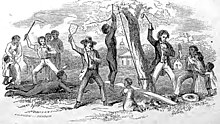
Back العبودية في الولايات المتحدة Arabic ABŞ-də köləlik Azerbaijani Esclavitud als Estats Units Catalan Slaveriet i USA Danish Sklaverei in den Vereinigten Staaten German Δουλεία στις ΗΠΑ Greek Slavery in the United States English Esclavitud en los Estados Unidos Spanish بردهداری در ایالات متحده آمریکا Persian Orjuus Yhdysvalloissa Finnish

Slavery in the United States was the legal institution of human slavery in the United States. Slaves were mostly Africans and African Americans. Slavery existed in the United States of America in the 18th and 19th centuries. Slavery existed in British America from early colonial days. Slavery was legal in all Thirteen Colonies at the time of the Declaration of Independence in 1776. It lasted in about half the states until 1865. This was when it was banned in the entire country by the Thirteenth Amendment.
By the time of the American Revolution (1775–1783), slaves had been institutionalized as a racial caste. The caste associated with African ancestry.[1] When the United States Constitution was ratified in 1789, a small number of free people of color were able to vote. This was because they were men who owned property.[2] During and shortly after the Revolutionary War, abolitionist laws were passed in most Northern states, and there was a movement created to end slavery. Slave states tried to extend slavery into new Western territories. They wanted to do this to keep their share of political power in the country. Southern leaders also wanted to annex Cuba as a slave territory. The United States became split over the issue of slavery. It was split into slave and free states. The Mason–Dixon line divided the country. The line divided (free) Pennsylvania from (slave) Maryland.
While Jefferson was president, Congress prohibited the importation of slaves, effective 1808. Although smuggling (illegal importing) through Spanish Florida was common.[3][4] Slave trading within the United States, however, continued at a fast pace. This was because there was a need for labor due to the creation of cotton plantations in the Deep South. New communities of African-American culture were created in the Deep South. There were 4 million slaves in the Deep South before they were set free.[5][6]
- ↑ Wood, Peter (2003). "The Birth of Race-Based Slavery". Slate. (May 19, 2015): Reprinted from "Strange New Land: Africans in Colonial America" by Peter H. Wood with permission from Oxford University Press. ©1996, 2003.
- ↑ Walton Jr, Hanes; Puckett, Sherman C.; Deskins, Donald R., eds. (2012). "Chapter 4". The African American Electorate: A Statistical History. Vol. I. CQ Press. p. 84. ISBN 978-087289508-9.
- ↑ Smith, Julia Floyd (1973). Slavery and Plantation Growth in Antebellum Florida, 1821–1860. Gainesville: University of Florida Press. pp. 44–46. ISBN 978-0-8130-0323-8.
- ↑ McDonough, Gary W. (1993). The Florida Negro. A Federal Writers' Project Legacy. University Press of Mississippi. ISBN 978-0878055883.
- ↑ Stephen D. Behrendt, David Richardson, and David Eltis, W. E. B. Du Bois Institute for African and African-American Research, Harvard University. Based on "records for 27,233 voyages that set out to obtain slaves for the Americas". Stephen Behrendt (1999). "Transatlantic Slave Trade". Africana: The Encyclopedia of the African and African American Experience. New York: Basic Civitas Books. ISBN 978-0-465-00071-5.
- ↑ Introduction – Social Aspects of the Civil War Archived July 14, 2007, at the Wayback Machine, National Park Service.